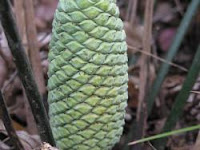 Have you ever been drawn in by a smell? The aroma of cookies fresh out of the oven, the fragrance of perfume, or the tantalizing scent of a flower? Smell can be a powerful motivator for all kinds of animals, from humans to lizards to insects. Recently, scientists here at the University of Utah unraveled the unusual secret of how one plant uses smell to its advantage.
Have you ever been drawn in by a smell? The aroma of cookies fresh out of the oven, the fragrance of perfume, or the tantalizing scent of a flower? Smell can be a powerful motivator for all kinds of animals, from humans to lizards to insects. Recently, scientists here at the University of Utah unraveled the unusual secret of how one plant uses smell to its advantage.
The Plant Meet Macrozamia lucida. This Australian wonder is a cycad, a primitive kind of plant that has been around since before the dinosaurs. If you're thinking it looks like a pine cone, you're right! Cycads, like pine trees and junipers, are gymnosperms, which means that they have seeds but not flowers. Instead, they produce cones.
Meet Macrozamia lucida. This Australian wonder is a cycad, a primitive kind of plant that has been around since before the dinosaurs. If you're thinking it looks like a pine cone, you're right! Cycads, like pine trees and junipers, are gymnosperms, which means that they have seeds but not flowers. Instead, they produce cones.
Irene Terry, a biologist at the University of Utah, recently set off to explore just how Macrozamia lucida makes its way through life - particularly, how it reproduces. Like humans, individuals of this species are either male or female. To reproduce, male sexual cells (pollen) must reach and combine with female sexual cells (ovules). For a long time, people thought that the wind moved the pollen from the male cycad cones into the female cones, but in 1999, Terry discovered that small insects, called thrips, were responsible for carrying the pollen from plant to plant. The Insects
The Insects
This particular species of thrips spends its life inside the male cycad cones, laying eggs and munching on Macrozamia lucida pollen. The female cones, with no pollen in them to eat, aren't appealing to the thrips. But the plant needs the insects to move some pollen into the female cones so that it can reproduce. How does the plant get the thrips to do that?
The Trick
The answer, it turns out, has to do with the power of smell. The plants let off a special chemical that, in small doses, smells wonderful to the thrips and attracts them. In high doses, though, the chemical is toxic to the thrips and repels them. So, to make sure the insects don't just spend all their time eating pollen in the male cones, every afternoon the male plants burn some of their stored sugars to create energy and heat themselves up. The extra-hot male plants release a high dose of the chemical, driving the thrips away. Many of them fly towards the females, which have an attractively low dose of the chemicals even as the males are too strong. Later, the male plants cool off, and the thrips return to their tasty homes. The whole cycle starts again the next day "until the males wear out and the females are happily pollinated," Terry says.
Have you ever been manipulated by smell? What smells attract you? What smells would you avoid?
Wednesday, October 31, 2007
Fun Plant Tricks with Smell
Subscribe to:
Post Comments (Atom)

0 comments:
Post a Comment